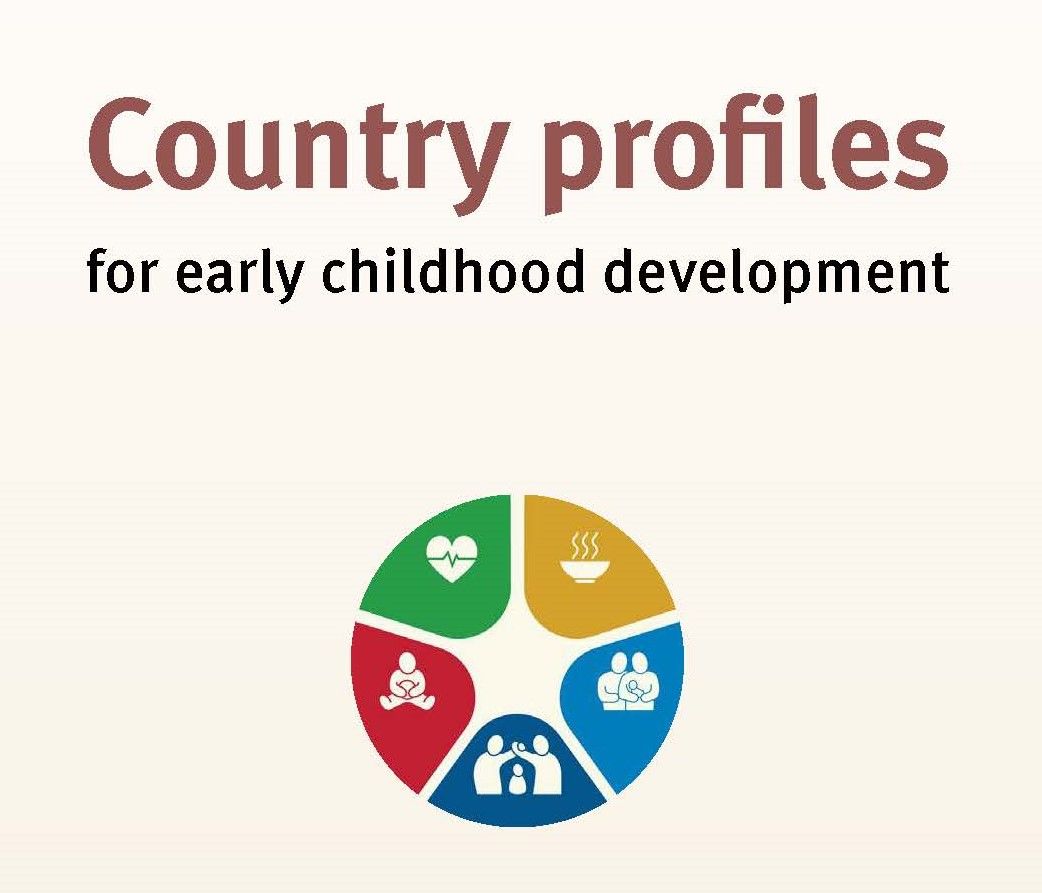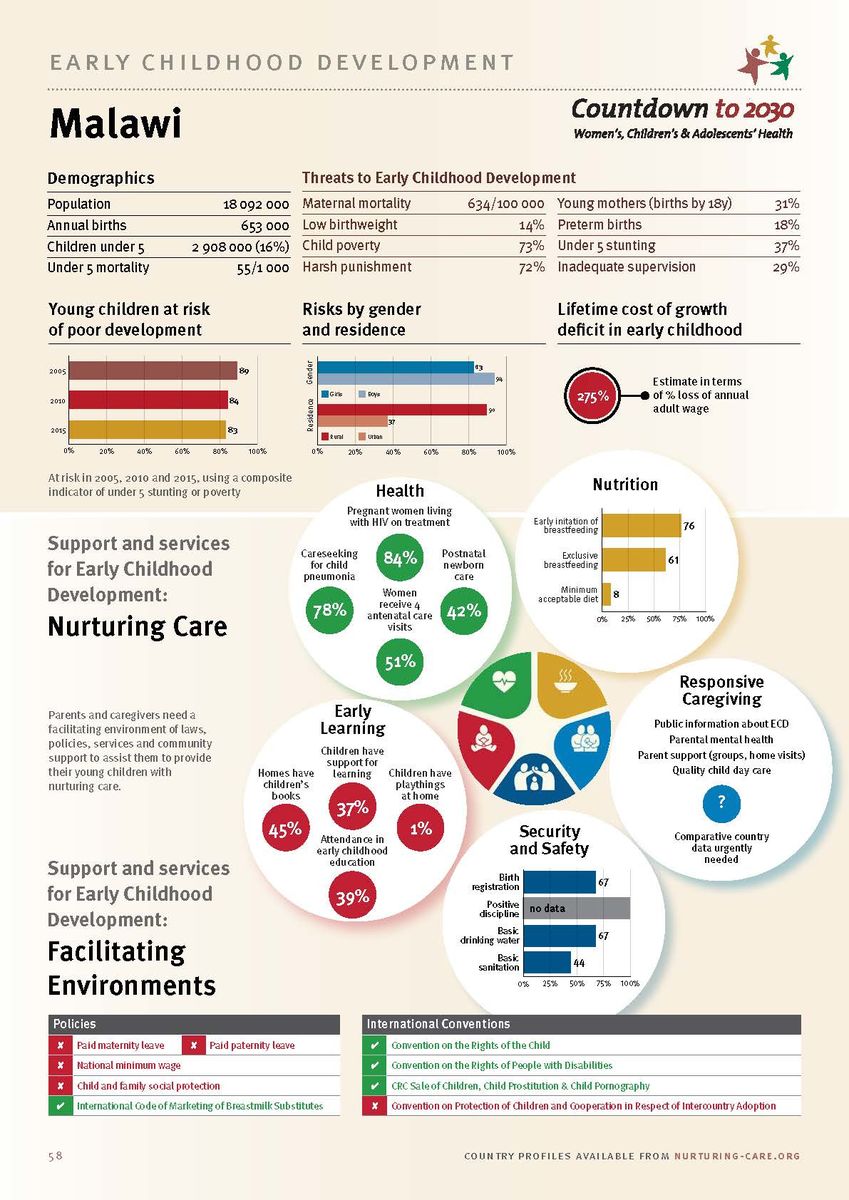Over the last couple of years, a great deal of progress has been made bringing attention to Early Childhood Development (ECD), including making ECD a priority in the 2030 Sustainable Development Goals (SDGs). Importantly, The Lancet series in 2017, Advancing Early Childhood Development: from Science to Scale, offered new scientific evidence and introduced the concept of “nurturing care” as a package of interventions that could be delivered at scale.
In May 2018, the adoption of the Nurturing Care Framework (the Framework) at the 71st World Health Assembly offered “a roadmap for action,” articulating how a whole-of-government and a whole-of-society approach can help children survive and thrive, thereby transforming their own potential and that of their societies. The Framework outlines strategic actions and suggests key ways of monitoring progress. It focuses on the youngest children, increasing political momentum by offering concrete recommendations for leaders and decision-makers at the country level. Yet, for progress to continue and to be meaningful, it must be informed by metrics.
That’s where our partner, University of the Witwatersrand (Wits), comes in. Led by renowned ECD expert Dr. Linda Richter, a group of scholars from The Lancet series created ECD country profiles for 91 low- and middle-income countries with high burdens of child mortality and risk of poor development. Each country profile fills a critical gap by making evidence on threats to early childhood development and coverage of policies and services easily accessible. This also represents the first step in creating a global monitoring and accountability system for ECD.

These country profiles build on the important work of Countdown to 2030 for Maternal Newborn Child and Adolescent Health (the Countdown), an initiative that aims to accelerate momentum to achieve the targets of the SDGs and catalyze efforts to achieve the vision of the Global Strategy for Women’s, Children’s and Adolescents’ Health. The country profiles also detail indicators for ECD, including numbers of children at risk (broken down by gender and residence, i.e. urban vs. rural), as well as progress in establishing an enabling environment through policies and supports, and the five aspects of nurturing care: health, nutrition, responsive caregiving, early learning, and security and safety. In addition, the profiles track country adoption, policies and conventions that help create a “facilitating environment” for nurturing care (e.g. paid maternity leave).
The core data for the profiles comes from USAID-funded Demographic and Health Surveys conducted regularly in more than 120 countries as well as UNICEF-funded Multiple Indicator Cluster Surveys (MICS) which, to date, have been conducted in more than 100 countries. Because the group were able to harmonize a decade of data collected on the burden of risk for childhood development, we can now see which countries have improved, which are getting worse, and which have stayed the same. Dr. Richter notes that having this data in hand is one of the most valuable aspects of the country profiles for advocates—as some countries have improved their outcomes by more than 20 percent between 2005 and 2015. Efforts to analyze these gains and to assess the factors that are enabling countries to make progress is now underway.
Policymakers and other decision-makers are often focused on the accuracy and the timeliness of the data, particularly in their own countries. This necessitates strict rules about the methodology of the data, causing researchers and analysts to sharpen definitions, tools and methods so that data is understood to be reliable by all stakeholders. Wits convened two workshops on the data focusing on indicators, data sources and design of the country profiles. Some key aspects of ECD (e.g. parental mental health and children living with disabilities) are not currently included in the country profiles, despite their importance, as country-comparable data has yet to be published. Encouragingly, UNICEF is including a module on child functioning as a tool for assessing disability in MICS6. As the data evolves, the country profiles will too—becoming “living” tools for improving outcomes for children. Updates of the country profiles will be presented at an event organized during the United Nations General Assembly in September 2019. This is made possible through the strong involvement of UNICEF which will maintain the data as part of its larger repository of information on children. The intention is that the profiles will not only inspire action but fuel advocacy for high-quality data, which is critical to increasing accountability and ensuring that the most vulnerable children and families are not left behind.
Establishing policies for integrated parental and family care for the youngest children can be complex, but the Countdown profiles, along with the Nurturing Care Framework, make that complexity concrete. These resources enable dialogue with health ministers and other leaders, allowing countries to benchmark their progress and understand what steps need to be taken to further improve outcomes for children.

The ongoing ECD measurement and monitoring work is formally part of the Countdown, and is convened through an ECD Technical Working Group, chaired by Dr. Richter. Amongst other things, the Working Group will be a forum for sharing, harmonizing and advancing measurement and monitoring for ECD. These efforts will identify priority measurement and monitoring opportunities, undertake secondary analyses when indicated, advocate for increased uptake of data, and contribute to the efforts of other Countdown Working Groups.
“Country, regional and global health authorities refer often to [the Countdown]. We wanted to be part of that well-respected effort and sharpen the focus on outcomes for the very youngest children, including everything a child needs to thrive,” notes Dr. Richter. “These profiles have so far generated enough interest that people can grasp the issues more deeply. Our hope is that our work will function not only to monitor country progress, but to also enable and drive country progress.” With the help of UNICEF and the ECD Technical Working Group, profiles are currently being prepared for 20 country countries in Eastern Europe.
The next step is the launch of a platform for valid population based interval scale measurement of early childhood development that would be feasible enough to go into a DHS and or a MICS survey and be administered at a country level. When the Global Development Scale, the result of a large international collaboration, becomes available, it will be the most direct outcome of efforts to measure the development of the youngest children across all countries, ensuring that it is tracked and that it drives our efforts to improve the early development of young children everywhere.